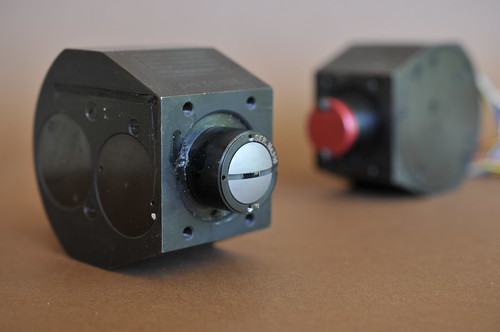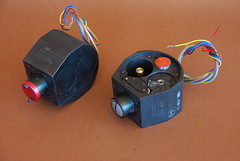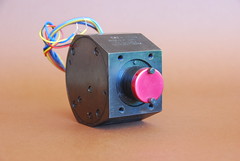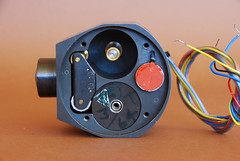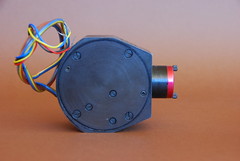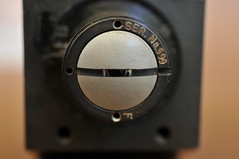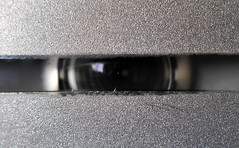The Weapons Research Establishment Roll Orientation Camera (WREROC) is one of a suite of specialised cameras developed in the mid- to late 1950s the Weapons Research Establishment (South Australia) in conjunction with the Anglo-British guided weapons development. WREROC was developed to record the roll (rotation) of a missile in flight in relation to the horizon. It drew on the Dixon lens developed for WRETAR cameras.[1]
Background
One of the major challenges encountered when testing missiles in the 1950s and early 1960s was to determine the amount and angle of roll during the flight. Some missiles intentionally used roll as a part of their stabilisation, while others developed roll during experiments. Ground observations were not always possible or accurate and in-flight telemetry was still in its infancy.
To document the nature and speed of missile roll, WRE developed a unique camera, the WREROC (WRE Roll Orientation Camera). It drew on the ultra wide lens[2] also used in WRETAR[3] and WRECISS[3][4][5]
The camera had to be designed very small and compact to fit into the missile, but also robust enough to withstand ground impact for those occasions where the missile crashed accidentally or where the standard parachute recovery was not used.[3].
Description
The extreme 186° fish-eye angle of the lens was restricted to a narrow slit of 2 mm width. The 35mm film was moved at a constant speed past the slit and was exposed at f/8 with an exposure time of 2 milliseconds. The camera had the capacity of 15 foot roll of colour film, which gave a total exposure time of 3 minutes. A time base was recorded at the film’s edge and three stadia lines were imprinted on the film.[3]
While technically a WREROC is a high speed cine camera, the resulting film was not projected as a movie. Rather, the resulting negative is a continual strip that shows the horizon throughout the duration of the flight.
Two cameras were installed in the missile at right angles to the roll axis, pointing in opposite directions. This dual installation provided instrumentation redundancy, but also removed ambiguity in situations where the white glare coming of salt lakes could be confused with the sky just above the horizon.[3]
The camera measures 7 x 8 x 5 cm (3 x 3 5/8 x 2 inches) and weighs 1.32kg (2.9 lb) ! It has been milled from a single piece of steel. Access to the internal mechanism (film advance, shutters, electro motor, diodes for time-base), as well as loading the unit with film, is achieved by two solid side plates that are securely bolted down in recessed (flush with the body).
Sample Images
Links
Notes
- ↑ For an in-depth description, see Spennemann (2015a); for full photographic documentation see Spennemann (2015b)
- ↑ Wide Angle Lens Systems.’ US Patent Filed 23 Dec 1957; Issued 18 Dec 1962. Applicants: Robert P. Bonnell, Jack V. Ramsey and Robert A Dillon, assigned to The Commonwealth of Australia. US Pat. Nº 3068752
- ↑ 3.0 3.1 3.2 3.3 3.4 Dixon, F.A. (1961) Cameras with Wide Fields of view used in Rocket Research at the Woomera Range, South Australia. In: K.J. Habell (ed.), Proceedings of the Conference on Optical Instruments and Techniques London 1961. New York: John Wiley & Sons. Pp.273-278.
- ↑ WRECISS—Weapons Research Establishment Camera Interception Single-Shot
- ↑ ‘Midget Camera for Guided Missiles.’ The Photographic Journal vol. 100, 1960, 173.—‘Midget Camera for Guided Missiles.’ Industrial and Commercial Photographer vol. 1, nº 2, 1960 p. 40.—‘Midget Camera for Guided Missiles.’ Aircraft Engineering vol. 32, 1960, p. 119.—‘Midget Camera for Guided Missiles.’ Military Review vol. 40, nº 1, 1960, p. 78.—‘Camera measures missile accuracy.’ Missiles and Rockets vol. 6, 1960, p. 32.—Beharrell, B | Collier, M J (1966) Photogrammetric methods applied to WRECISS computation (Photogrammetric methods applied to calculation of target position and attitude relative to missile). WRE Technical Note TRD-22, 16pp. Salisbury (Australia): Weapons Research Establishment, Dept. of Supply
